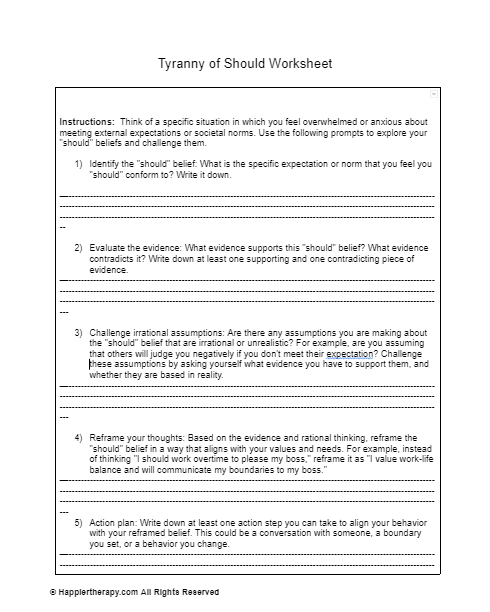Cognitive Distortions: Catastrophizing Worksheet
Premium Content
Access this worksheet and 2,500 mental health worksheets. Cancel anytime
Introduction:
According to the American Psychological Association (APA), cognitive distortion can be defined as faulty or inaccurate thinking, perception or belief. (APA, © 2022) Often at times, cognitive distortions fuel our anxiety and increase our misery.
Unlock deeper healing — upgrade to Premium now!
Customizable and fillable worksheets
Rights to alter the worksheets
Over 2000 worksheets
Support HappierTherapy
There are a number of cognitive distortions identified in Cognitive Behavioral Therapy, the most common include:
- All-or-Nothing Thinking/ Polarized Thinking
- Overgeneralization
- Mental Filter
- Catastrophizing/ Magnification or Minimization
- Mind Reading/ Jumping to Conclusions
- Predicting the future
- Emotional Reasoning
- “Should” Statements
- Labelling
10. Personalization and Blame
This particular worksheet will focus on: CATASTROPHIZING.
What Are The Theories Behind This Worksheet?
Catastrophizing is one of the cognitive distortions characterized by one’s worst possible outcome of their imagination.
Catastrophizing occurs when people subconsciously assume that the worst-case scenario will happen. The negative “what-if” thinking causes someone battling with this cognitive distortion to live in a constant state of crisis. (Straight Talk Counselling, 2021)
Additionally, when people catastrophize, they get into the head-space where they believe terrible things will happen (regardless of the situation) and as a result, they become more hopeless and helpless.
Research involving catastrophizing indicates that it could occur as a result of a coping mechanism learned from people with Generalized Anxiety Disorder (GAD), Post Traumatic Stress Disorder (PTSD), Obsessive-Compulsive Disorder (OCD), or other depressive conditions.
How Will This Worksheet Help You?
This worksheet is targeted to help individuals accept themselves, think realistically about the past, present and future, and most importantly, practise excellent self-care.
This can be done by putting one’s experience into perspective and reframing from thoughts regarding any unpleasant experience you may be going through.
This worksheet will also help you bring awareness to all situations you may experience: the more aware you are the, more relatable you are with your emotions.
How Should You Use This Worksheet?
Your thoughts, emotions and actions play a big role in shaping how you perceive yourself, others and the world around you.
There are effective ways of managing catastrophizing. Some of them include; practising stress-relieving techniques, journaling, engaging in activities that make you feel accomplished and taking you out of your comfort zone.
You should use this worksheet as a guide to your daily journaling, practising mindfulness, as well as a self-evaluation kit.
Was this helpful?
References
1.-
American Psychological Association. (© 2022). Ce Distortion. Available at:
https://dictionary.apa.org/cognitive-distortion. [Accessed October 05, 2022].
2.-
Straight Talk Counselling. (2021). Why Do We Catastrophize? How to End Worst-Case-Scenario Thinking. Available at: https://www.straighttalkcounseling.org/post/why-do-we-catastrophize-how-to-end-worst-case-scenario-thinking. [Accessed October 14, 2022].

 By
By

